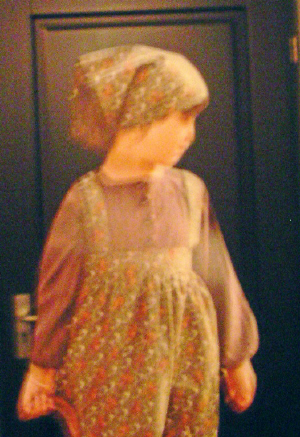 |
|
Little girl who appeared on Nancy's
camera at Easter, 2008.
Photo: Robbert v/d Broeke
|
"Nothing is more dangerous than an idea--
when it's the only one you have."
---Emile Chartier
All photographs in this report were taken by Robbert van den Broeke,
unless otherwise noted. None may be reproduced in any format
without written permission from him or Nancy Talbott.
Text is © by Nancy Talbott, BLT Research Team Inc.
|
Introduction
On Sunday afternoons during the 1950s, when I was a teenager growing up in Maryland, I and some friends often drove our '39 Ford Phaeton north to a remote clearing in the forests of southern Pennsylvania. Called Sunset Park, it was a hidden place down among the trees at the end of a winding dirt path where the local Amish came to attend "Sunday Go To Meeting"--and we "city" kids (a few musicians who had discovered this place) came to hear the fabulous Blue Grass bands which played music after the preacher was finished.
On my first visit, as we pulled the old Ford off the dirt track into some bushes, I heard the bell-like ring of a 5-string banjo for the first time and--without even guessing what was happening to me--my heart was commandeered. The Stanley Brothers, Ralph and Carter (one of the great early Appalachian Blue Grass bands) were on stage...and I was transfixed.
I grew up with college-educated middle-class parents, attending preparatory schools and regularly taken to wonderful performances of Gilbert & Sullivan, or the opera and ballet--but I had never heard anything even vaguely like Blue Grass music. I didn't even know it existed. But of course it did--just in another world...one not known to my parents.
This report is about another previously unknown and totally unanticipated reality I happened upon as an adult, a discovery as amazing to me as Blue Grass music was so many years ago, but with perhaps more profound implications. If I had not personally stood and watched as my young Dutch friend, Robbert van den Broeke, took many of the photographs presented here--using my own camera--I would certainly not have thought that images of people who have died could suddenly appear in photographs being taken months, or years, after their deaths. [At least not in the absence of chicanery of some sort being involved.] But the fact is that such images can, and do, appear regularly--on many different cameras--if these cameras are in Robbert's hands.
My purpose in presenting this information is not to convince the reader of anything other than the fact that the photographs are real--there is no mechanical or technical fakery of any kind behind them. They have been spontaneously occurring for many years now, and continue to do so. What they may "mean" I can't with any authority say, but I will do my best to tell you Robbert's thoughts on the matter.
After moving to Massachusetts my continuing love of Blue Grass led me to produce music concerts throughout New England and eventually a 4-day outdoor music show--The Berkshire Mountains Blue Grass Festival--which I produced for 10 years in upstate New York. During these years I got to know many of the Appalachian musicians and their families well, staying in their homes and traveling on the road with them during tours. And it was not just this fabulous music which so delighted me. As I got to know the musicians I became increasingly aware of their unerringly accurate insight into the grittiest aspects of the human condition which, in some of them, resulted not only in great music and songwriting but also produced a truly rapier-like wit. If I'd never loved the music I would most likely have hung around these musicians anyway, just for the conversation--Lenny Bruce and Richard Pryor had nothing on these guys.
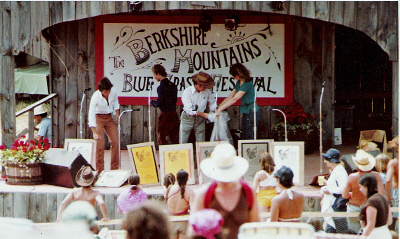 |
|
Don Stover and Nancy at the 2nd annual Berkshire Mts.
Blue Grass Festival (1977). Photo: N. Talbott
|
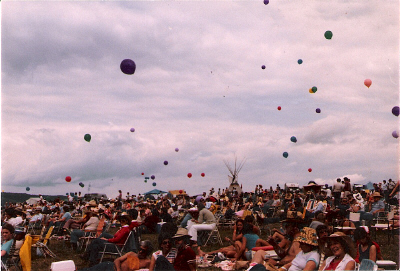 |
|
The Berkshire Mts. Blue Grass Festival audience, sometime in the 1980s.
The "teepee" & balloons were there every year.
Photo: N. Talbott
|
Many mountain families of the southeastern U.S. have strong emotional bonds, and the appearance of loved ones after death is not necessarily thought of as entirely strange. Appalachian people call such apparitions "haints," and generally seem to find them consoling, rather than frightening or disturbing. And during my travels through some parts of Europe I have seen this same closeness of families in many countries, and a similar relaxed acceptance of realities perhaps not apparent to some of the rest of us.
I remember Ralph Stanley (the banjo player I heard that first day at Sunset Park) telling me about seeing his brother Carter appear, after Carter's death, out on the mountaintop near his gravesite. And just a few years ago Greg Allen (another of my favorite banjo players and son of the great Blue Grass tenor, Red Allen) told me about seeing his half-sister Debbie appear and put her arms around her parents as they knelt next to her casket during her funeral a few years ago, in Dayton, Ohio. To Greg, the appearance of his half-sister's apparition didn't seem really unusual at all; instead he was certain Debbie had appeared to comfort her parents and to let them know she was alright.
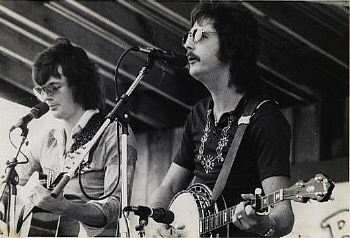 |
|
The Allen Brothers (Harley on guitar, Greg on 5-string banjo) at the
Berkshire Mts. Blue Grass Festival during the 1970s.
Photo: N. Talbott
|
Although many people around the world accept that "ghost" or "spirit" images can and sometimes do occur, Robbert v/d Broeke is the only person I have ever heard of who has taken literally hundreds of photos with such clear images of people that they can be identified with certainty. Some of these images have been of Robbert's own deceased relatives, others are well-known public figures or people related to Robbert's clients. In 2007, while Robbert and I were out in a field in Holland where crop circles had appeared earlier that year, my own brother's face appeared in more than 60 photographs--two months after he had died.
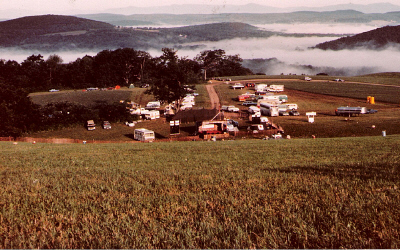 |
|
The view of the Berkshire Mountains foothills in NY State from the
top of the Festival's natural amphitheater. Photo: N.Talbott
|
The term "apparition" photos is used in this report primarily because it is the least biased label I could find in the English language. I debated the term "spirit" photos, but this label incorporates the bias that the images actually represent the presence of the souls or spirits of people who have died--a concept I cannot prove. In fact, since we have not been able to identify all of the people whose images have appeared, we aren't certain that all of the photographs represent people who are, in fact, deceased.
As has been the case with Robbert's "Light Phenomena" photographs (http://www.bltresearch.com/robbert/photoanoms1.php) and his "UFO" photos (http://www.bltresearch.com/robbert/ufophotos.php), all of the various cameras used by Robbert when he obtains the "apparition" images are always set in the "auto" mode. Another apparently related fact is that when the images of people appear (unlike the conditions attendant to the "light phenomena" photos)-- regardless of the actual ambient light conditions, the flash NEVER goes off. If the photographs with images of people in them are interspersed with other normal photos, or photos that only show "light" anomalies, the flash will go off if the ambient light conditions require it--but not if/when the people images begin to occur again, regardless of the ambient light conditions.
A few more pertinent details. At any given moment the photographic anomalies occurring tend to be of one type only. If what we have called "light phenomena" photos are occurring, the "apparition" type photos will not be, and vice-versa. There are some occasions when this is not true--when a variety of different kinds of anomalies will occur interspersed with one another--but usually it will be one sort or another during a specific time-period. And, as with the "light phenomena" photos, Robbert usually states that he can feel a very specific, unusual "energy" or "presence" in his immediate vicinity just prior to the "apparition" photographs beginning.
And, finally--in spite of the cognitive dissonance I know this statement will cause some readers--there is no computer involved. Robbert did not have a computer, or any access to a computer, until July 4, 2006. Also, although he does now have one, he is very limited in his utilization of the machine. [Several years ago Robbert was highly amused when it was explained to him what people meant when they had accused him of "googling" to produce various images which had appeared on his camera. At the time he had no idea what "googling" was.]
As will be seen below we have been able to establish that some of the "apparition" images Robbert obtains on camera are close approximations of previously existing photographs (or printed versions of photos) which we (and others) have been able to locate. This may be a clue to at least part of what is going on, although it definitely increases the challenge of presenting this material to the general public.
Basic facts regarding Robbert's "apparition" photos:
(01) Robbert usually feels a distinct "energy presence" as images begin;
(02) He aims any camera toward this "presence" & takes the photo;
(03) The cameras are always set in the "auto" mode;
(04) The images do not appear on the LED screens until Robbert actually
depresses the "record" button;
(05) The "apparition" images, if they are occurring, then appear instantly;
(06) Multiple cameras used within a specific time-period may all produce
images of the same "apparition;"
(07) Multiple images of totally different figures may appear in one session;
(08) Some individual images have appeared up to 60 times;
(09) These images occur as readily in daytime as they do at night;
(10) They are occurring with much greater frequency recently;
(11) No one who has watched Robbert while he is taking these photos has
ever observed him to hold anything in front of the lens;
(12) Regardless of the available ambient light, the flash never fires.
- and there is NO computer involved -
|
The Early "Apparition" Photos
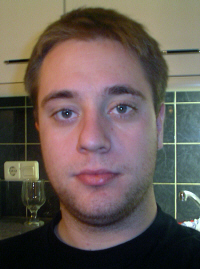 |
|
Robbert v/d Broeke in late 2003, around
the time the "apparition" images began
appearing. Photo: N. Talbott
|
To the best of my knowledge these "apparition" images first began appearing on Robbert's camera in the winter of 2003-2004. Sometimes the people in these photos were recognized by Robbert, or his parents, as representative of deceased family members. In one instance an image of a mature woman's face had appeared several times and, when Mrs. v/d Broeke showed me a photograph of her mother (Robbert's maternal grandmother) taken fairly late in life, it was clearly the same woman's face which had, years after her death, appeared in Robbert's photographs.
All of the "apparition" photos here are the originals, totally unaltered.
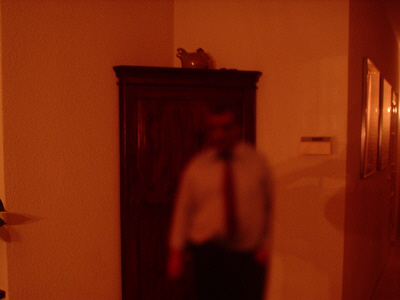 |
|
May 23, 2004 - Image of an uncle of Robbert's who died in 2000. In this case
(as in all of the photos with images of people) the flash did not fire.
|
In May, 2004 several photos occurred of a man who was recognized as Robbert's deceased uncle (above). Other deceased family members also appeared in some of these early photographs and I remember a particularly poignant one of a very young child whom Mrs. v/d Broeke identified as her deceased twin sister, a child who had lived only a short time after birth.
"Apparition" Photos On a Client's Camera
By 2004 people had begun to come to Robbert for "healing" sessions or "readings," and frequently they came asking for information regarding their deceased relatives or loved ones. During these sessions with clients Robbert began to "see" figures of people he "knew" were related to the clients--often the figures were standing around the clients as they sat across from Robbert's desk. [I am not entirely clear about whether Robbert always "saw" these people in his "mind's eye" or, perhaps in some cases, visually.] But he began to document these sessions by taking photographs in which human figures appeared, images which (as identified by Robbert's clients) accurately depicted the client's loved ones Robbert "knew" were present and about whom they were inquiring.
At first Robbert used his own camera to take these photographs. But soon he began to use cameras brought to the sessions by his clients--most of whom he had not met previously. In my interviews with one of these clients, Mrs. William Koevoets, she recounted that she had come to see Robbert in the summer of 2007 because she had been experiencing the feeling of "someone looking at" her while she was alone working on a new home she and her husband were building.
Not knowing what or who this presence might be, or whether she might be "dreaming," she asked Robbert if he could help her understand what was happening.
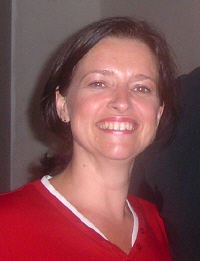 |
|
Mrs. William Koevoets. Photo: N.Talbott.
|
Upon hearing Mrs. Koevoets' question Robbert became aware of an elderly male neighbor of hers who had died many years earlier--but whom she had never known personally. On July 25th Robbert visited Mrs. Koevoets' new house and, using Mrs. Koevoets' camera, captured multiple vague images of an elderly man inside the house. After Robbert's visit and his photographs of the elderly neighbor, Mrs. Koevoets never again experienced the feeling of someone being present and "looking at" her while she worked on the house.
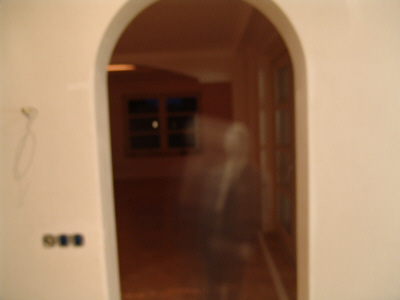 |
|
One of 8 photos Robbert took with Mrs. Koevoets' camera showing images
thought to represent her deceased neighbor.
|
While alone in his office at home a week after getting the images of Mrs. Koevoets' deceased neighbor, Robbert suddenly felt the presence of Mrs. Koevoets' mother, accompanied by a clear understandiing that the mother desired contact with her daughter. Robbert called Mrs. Koevoets to give her this information and an appointment was made for him to return to the new house to take some more photos with this client's camera.
Mrs. Koevoets' mother, Bertha Boere, had died in January, 2002, not very long after she had been given a particularly lovely dress by her daughter. Photos of Mrs. Boere had been taken in this special dress and her body was cremated in it after her death. But Robbert had never met Mrs. Boere and had not been shown any photos of her, and knew nothing at all about the special dress.
On August 1, 2007, again using Mrs. Koevoets' digital camera and with her standing next to him "looking over his shoulder," Robbert revisited the still unfinished house with his client. As he became aware that Mrs. Koevoets' mother was present he waved his hand toward the part of the room where he perceived the mother's "energy" and then began taking photos. After taking multiple images, Robbert and Mrs. Koevoets together looked back through the photos to see what, if anything, had appeared on them.
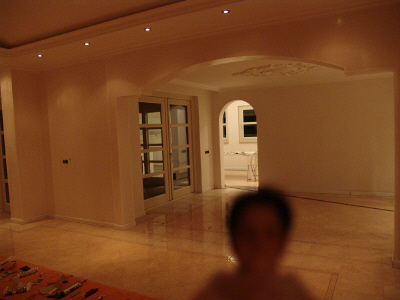 |
 |
|
Two of the dozen or so images of the same woman taken with Mrs. Koevoet's
camera on August 1, 2007. The flash did not fire.
|
As soon as Mrs. Koevoets saw these images she recognized them as her mother. Robbert, who had no "normal" knowledge of what the mother had looked like, was equally certain that the images were of his client's mother--based on his previous experience with Mrs. Boere's energetic "presence" in his office the previous week. Robbert also "knew" that the mother would try to appear on the camera so as to fulfill a promise she had made five years earlier to her daughter, just a few days prior to her death--a promise to let her daughter know that she was allright, if there was any way to do this.
According to Mrs. Koevoets neither she nor anyone in her family had known Robbert, or had even heard about him, prior to Mrs. Boere's death. She also firmly stated that Robbert had never been shown any photographs of her mother and that no photo of her mother had ever appeared in any public forum--and absolutely not on the internet.
When I interviewed Mrs. Koevoets she told me that when she saw the photos she understood that her mother had "kept her promise. It was the happiest day in a very long, long time." Wanting to show Robbert the photograph she had taken a few months before her mother's death, they returned to the house the family still occupied, where Mrs. Koevoets retrieved the portrait from inside her desk and, for the first time, showed it to Robbert.
 |
|
Mrs. Bertha Boere in her special dress.
Photo taken in October, 2001, three
months before her death.
Photo: Mrs. William Koevoets
|
Although the images taken by Robbert seem (even to those of us who did not know her) to represent Mrs. Boere wearing this particular dress they are not clear enough to determine whether the pose, facial expression and dress are exactly the same as in Mrs. Koevoets' photograph. But it seems likely that the images are of the deceased woman, wearing the same dress as in the portrait.
This question as to whether or not the images of this sort which appear on Robbert's camera(s) are precise copies of existing photographs is both an interesting one, and a lot more complex than is immediately apparent. In this case one possibility is that this particular image may have arisen in Mrs. Koevoets' mind upon hearing from Robbert that her mother desired contact. This particular photo of Mrs. Boere was framed and her daughter did have a copy of it in her desk, so one can assume she was familiar with it.
If we pursue this line of reasoning we must consider the fact that Robbert can apparently "read" people's minds (see the Easter Basket incident reported on Robbert's BLT page: http://www.bltresearch.com/robbert.php). And, so, one possible approach in trying to understand part of this event would be to assume that Mrs. Koevoets did produce a mental image of her mother's portrait when told by Robbert that her mother wanted contact, and that Robbert then could, and did, "see" the image in Mrs. Koevoets' mind--which image he subsequently somehow photographed with his client's camera a week or so later.
Remember that the camera used here was Mrs.Koevoets' camera--and that Robbert had no access to it prior to her handing it to him and that she stood right next to him as he took the photos. And remember also that Robbert had never physically met the mother, nor seen or had any access to any photographs of her. Note also that Robbert and Mrs. Koevoets saw the images of Mrs. Boere on the camera's LED screen right away--immediately after Robbert took this series of shots.
In this case it may also be relevant that Mrs. Koevoets had not originally come to see Robbert because of questions about her mother--her concerns had been about the strange "presence" she felt was "watching" her when she was in her new home.
Even if Robbert's call to Mrs. Koevoets to report that her mother desired contact had caused the mother's portrait to arise in the daughter's mind, and even if Robbert had "read" Mrs. Koevoets' mind and "seen" the portrait of her mother that way--how did he transfer that mental image in his "mind's eye" to his client's camera's chip while she was standing right there watching him? I asked Mrs. Koevoets if she thought there was any possibility that Robbert could have drawn a small image of her mother (based on his ability to "see" what is in other people's minds) and then held this up in front of the lens (without her seeing this) while taking the photos that night? Mrs. Koevoets is quite intelligent. Although she gave me a strange look at the question, her answer was a very clear "no."
The Soldier Photos
Late on a Saturday evening three years earlier (and two years before he had his first computer) Robbert had been sitting in his living room at home when he became aware of a strong presence in the room--and suddenly saw (more in his mind's eye than actually something visual) a clear image of a group of soldiers. He could "see" their helmets and the color and many details of their uniforms and also experienced a profound sense of their solidarity, the strong friendships and loyalties between the men. At first Robbert felt some fear as he recognized their cohesion and fighting capability, but then became aware that they had appeared not to harm him, but to help guide or protect him in some way.
Robbert took a number of photos that night and one soldier in particular appeared several times. The next morning Robbert's father found the camera lying on the sofa...with a dozen or so photos of this one soldier on the chip.
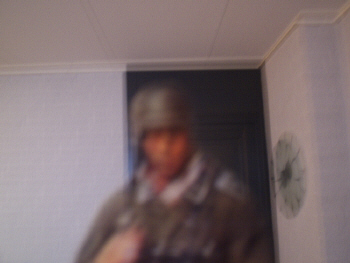 |
|
This first soldier photo was taken during the night of August 29-30,
2004, but is too blurred to work with. Flash did not fire
in any of the soldier shots.
|
Wanting to learn what he could about the soldier in these photographs Robbert's father (Peter) decided to ask a retired Army General who had very recently moved into the neighborhood for help. Peter showed the military neighbor the clearest photo of the set, which the retired General immediately identified as a German infantry soldier from WW II.
The General said he had a book upstairs which would help him identify the soldier's regiment, and he went upstairs to find it. When he came back with the book he put it down on a table and--to both men's surprise--the book opened to the exact page upon which, it turned out, Robbert's soldier was pictured. But the soldier which appeared on Robbert's camera that night (and on multiple other nights) is just one of the men in a long line of German soldiers marching along a street.
The caption under the soldier photo in the book (part of a series of popular books about WW II, written in Dutch) says that the soldiers are German infantrymen walking through a village in Belgium on their way to fight the French and British forces. No date or photographer is given, but in text elsewhere in the book it states that most of the photos used in this book came from "obscure archives" relating to the 1940s.
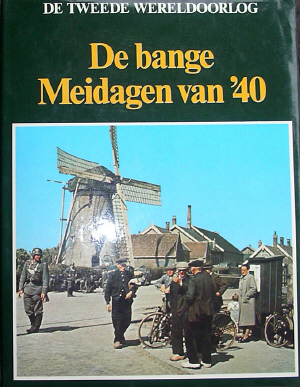 |
|
Cover of book owned by Robbert's retired military neighbor.
Photo: N. Talbott
|
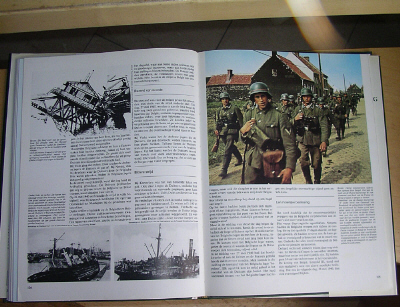 |
|
Photo of page to which book opened spontaneously.
Photo: N. Talbott
|
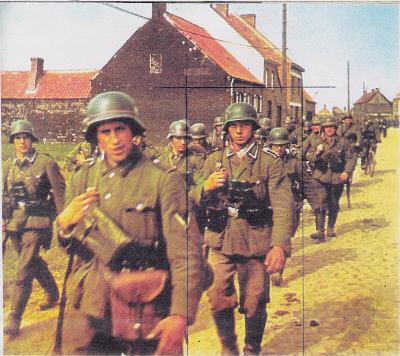 |
|
Blown-up Xerox copy of soldier photo in book. The second soldier in the line
(outlined in black rectangle) is the one who repeatedly appeared
in Robbert's photos. Xerox: Peter v/d Broeke
|
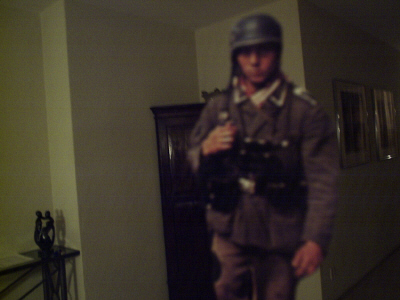 |
|
The clearest of Robbert's soldier photos (Soldier #3). Note dark semi-circle on
right thigh & missing area of right elbow--compare to photo in book.
|
To be absolutely clear here, the ex-military man who owns this book had just moved into the neighborhood and Robbert had not yet met him. Generally, Robbert has no particular interest in soldiers or war and he was unaware of the existence of this book. And (in the event that this photograph may have existed on the internet) it must again be stated--Robbert did not have a computer in 2004, nor did he have access to one.
Photo Analyst's Work on Soldier Photos
As in our earlier "Light Phenomena" photos report we asked an MIT-trained computer specialist and photo analyst to take a look at the "soldier" photos. MIT is one of the world's leading academic institutions and is located near the BLT office in Cambridge, Massachusetts--and most of the MIT faculty I've met are highly skeptical (as well as mostly uninformed, or quite mis-informed) regarding such things as crop circles or the sort of events that occur around Robbert van den Broeke.
Our photo analyst is, as expected, very uncomfortable with the idea that these photographs could possibly be occurring in the manner and under the circumstances I have described to him. But, unlike many people with strong scientific backgrounds, he has been willing to apply his expertise to an examination of some of this material. I have not asked him to determine whether these "apparition" photos are occurring as I have stated--he doesn't have (and cannot have, without spending time with Robbert himself) enough information to do this. I've only asked him to tell me what he could about whether various pre-existing images we (and others) have found are, or are not, replicas of some of the images which appear in Robbert's photographs.
Step #1: the analyst begins by carefully tracing a red outline around the soldier pictured in the book who most closely resembles Robbert's clearest soldier photo. In addition, the analyst has placed small registration dots (circular inserts on photo show red dot placements, magnified) in the direct center of various bright spots in the book image--both in the upper and lower parts of the soldier's body. The dots are very small so that they could be placed very precisely in various places on the soldier's body, thus providing multiple reference points.
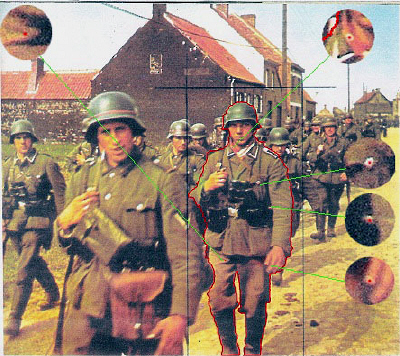 |
|
The analyst first draws a red outline around the soldier's body in the book image &
then places red dots (blow-ups in circles) to mark specific reference points.
Image: BLT Photo Analyst
|
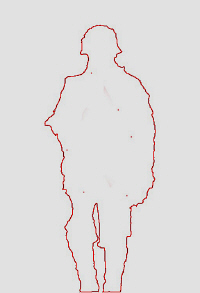 |
|
Step #1: the red outlined silhouette &
red-dot placement from soldier in
book. Image: BLT Photo Analyst
|
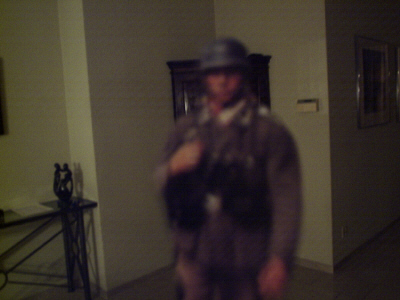 |
|
Another of Robbert's original soldier photos ("Soldier #2").
|
Step #2: The analyst then re-sizes Robbert's "Soldier #2" photo so that it matches the size of the soldier in the book and superimposes the re-sized photo over the book image to check for size accuracy.
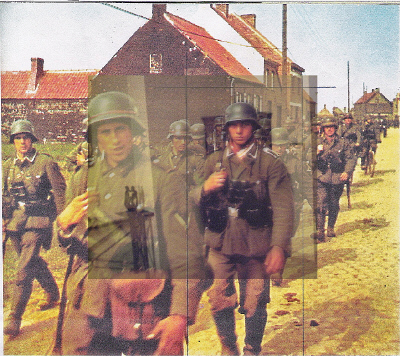 |
|
Step #2: analyst then re-sizes Robbert's "Soldier #2" photo & superimposes it
over the book image to check accuracy of re-sizing.
Image: BLT photo analyst
|
Step #3: Once he is sure that Robbert's "Soldier #2" photo has been re-sized to accurately match the book soldier, the analyst then superimposes the red silhouette with its red "registration" dots over Robbert's "Soldier #2" photo.
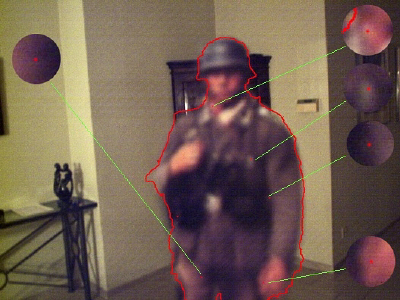 |
|
Step #3: the accurately-sized red silhouette & registration dots are
superimposed over Robbert's Soldier #2 photo.
Image: BLT photo analyst.
|
After multiple attempts to place the variously re-sized red silhouette from the book image over Robbert's "Soldier #2" photo it is apparent that it will not fit exactly, particularly around the soldier's left wrist and hand. Also, the bright button on the book soldier's right chest pocket (where our analyst has put a red dot) was round in the book photo--but in Robbert's soldier #2 photo the button is rectangular (approx. 1.5" high x 3/4" wide)--different from both the book image and another of Robbert's soldier photos which we will examine next.
One can also see that Robbert's soldier #2 image does not include the flare of the helmet (particularly on this soldier's left side) that is visible in the book photo and, most interestingly, the red dot which the analyst had placed on the book soldier's right thumb-nail is now on soldier #2's index finger. Also, the red dot placed by our analyst above the crease on the upper right thigh of the book soldier's uniform is now below that crease.
 |
|
Now let's look at the clearest of Robbert's soldier photos ("Soldier #3") again.
|
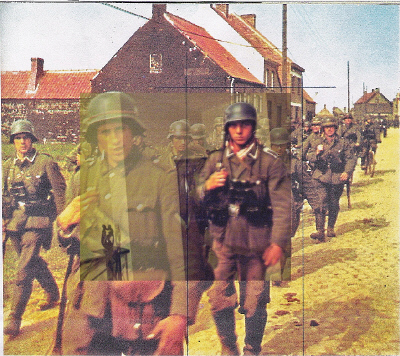 |
|
Robbert's soldier #3 re-sized & then superimposed over book soldier to
check sizing accuracy. Image: BLT photo analyst.
|
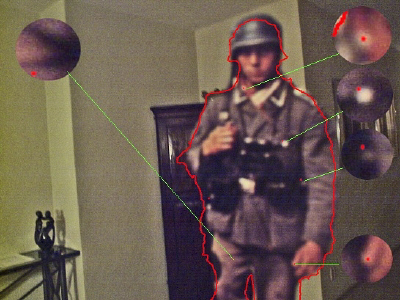 |
|
One of multiple attempts to align the red outline & registration dots (from the
book image) with Robbert's soldier #3 photo.
Image: BLT photo analyst.
|
Many attempts were made to try to align the red outline and dots from the book image to Robbert's soldier #3 image. In one attempt our analyst aligned the red dots on the soldier's neck and thumb-nail, but this causes the chest and belt dots, as well as the red dot on the soldier's upper right thigh, to no longer be in the center of those bright areas (as they are in the book image). Also the red-line silhouette clearly does not match the black semi-circle indentation on soldier #3's right thigh (created by a canteen or some other piece of equipment carried by the soldier in front of him in the book photo), nor the head and helmet, etc.
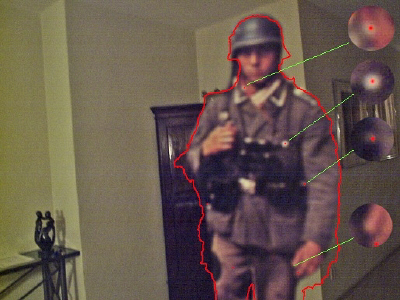 |
|
Another attempt to align the red outline & red dots from book image with
Robbert's soldier #3 photo. Image: BLT photo analyst.
|
Another attempt to align the book image's red silhouette and red dots with Robbert's soldier #3 photo (this time by re-sizing the silhouette and matching up the neck, chest button and belt red dots) clearly shows again that the two images do not match. Looking at this alignment we see immediately that the red dot on the book image's thumb-nail now appears on soldier #3's index finger (the third finger on his right hand seems also to be missing). And the red-line silhouette does not match at all around soldier #3's left hand and left leg or the upper right thigh--where a dark semi-circle appears in both the book image and Robbert's images, caused by a canteen or some other piece of equipment carried by the soldier walking in front of "our" man. This dark semi-circle is totally off in every attempt to align Robbert's soldier #3 with the book image.
And, although our photo analyst did not point this out, the red dot on soldier #3's upper right thigh (placed above that first crease in his pants leg on the book image) is now down below the 2nd crease. It just doesn't match at all.
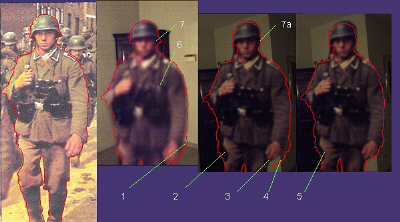 |
|
Soldier in book (on left) & two of Robbert's photos (soldiers #2 and #3).
Composite: BLT Photo Analyst
|
The analyst tried many different sizings and distortions of Robbert's "soldier" photos in his attempts to produce a match with the soldier photo in the book, but was unable to do so. He states that "soldier #2 is a closer match [which] perhaps could have been derived somehow from the book photo" (perhaps using paste and scissors and Photoshop manipulation?)--the two primary problems here being (a) that Robbert had never seen the book at the time these photos were taken, and (b) Robbert didn't have a computer in 2004, much less the expertise required to work in Photoshop.
With soldier #3 photo the results are clearer. The missing helmet "flare," the inaccurate profile around the left arm, the fact that the red-dots will not line up "no matter how you do it," and the obviously inaccurate red outline around the dark semi-circle on the soldier's right thigh all show Robbert's photo is not a direct copy of the book photo.
Our MIT-educated analyst felt there was a 70% probability that the soldier in Robbert's photos is the same man shown in the book photo but concluded that "with all this detail, one can definitely say that soldier #2 and soldier #3 are not direct copies of the book photo."
He added that, in his opinion, even "Photoshopping the [red] outline region [around the book image] doesn't fully explain the lack of alignment of the [red] dots."
Our analyst wondered if perhaps the image in the book could be a "still," a single frame taken from a film shot by a movie camera--because if this were so it would at least provide the possibility that the precise soldier images which appeared on Robbert's camera actually do exist (or did) somewhere, at some time, in our "normal" physical reality. And although this is a thoughtful attempt to resolve the conundrum, as an actual solution it would require a whole slew of facts to be in evidence which are not.
There is no photographer mentioned in the book, no precise dates, etc., only that many of the photos had been found in "obscure" war archives. The idea that Robbert had somehow discovered and then gained access to such archives (whether they contained actual movie film or not), and then had either stolen or copied whatever soldier images he had found so that he could subsequently produce soldier photos on his camera at home is--to anyone who actually knows Robbert--truly absurd.
Given the actual circumstances it seems more reasonable to me to consider the possibility that, although Robbert's soldier photos do appear to represent the same infantryman and probably the same situation and time-frame as is illustrated in the neighbor's book, perhaps Robbert's photos actually do show this soldier at multiple, slightly different moments in time?
Top | Continue to Part 2 >>
© 2010 BLT Research Team Inc.
All Rights Reserved
|
|


























